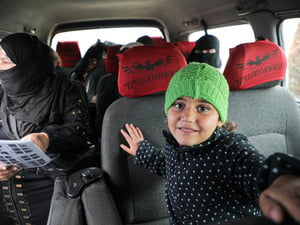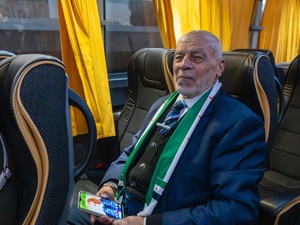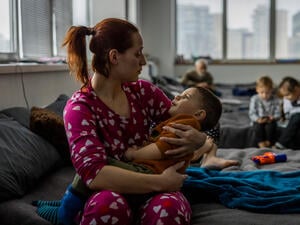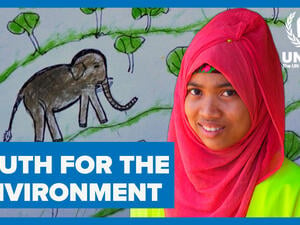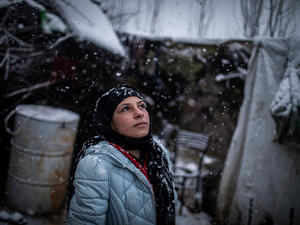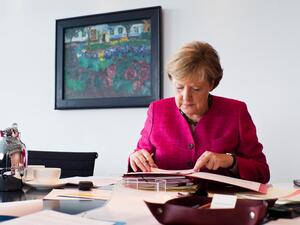Forced displacement above 68m in 2017, new global deal on refugees critical
Forced displacement above 68m in 2017, new global deal on refugees critical

Young Rohingya refugees look out over Palong Khali refugee camp, a sprawling site located on a hilly area near the Myanmar border in south-east Bangladesh.
Wars, other violence and persecution drove worldwide forced displacement to a new high in 2017 for the fifth year in a row, led by the crisis in Democratic Republic of the Congo, South Sudan’s war, and the flight into Bangladesh from Myanmar of hundreds of thousands of Rohingya refugees. Overwhelmingly it is developing countries that are most affected.
In its annual Global Trends report, released today, UNHCR, the UN Refugee Agency said 68.5 million people were displaced as of the end of 2017. Among them were 16.2 million people who became displaced during 2017 itself, either for the first time or repeatedly – indicating a huge number of people on the move and equivalent to 44,500 people being displaced each day, or a person becoming displaced every two seconds.
Refugees who have fled their countries to escape conflict and persecution accounted for 25.4 million of the 68.5 million. This is 2.9 million more than in 2016, also the biggest increase UNHCR has seen in a single year. Asylum-seekers, who were still awaiting the outcome of their claims to refugee status as of 31 December 2017, meanwhile rose by around 300,000 to 3.1 million. People displaced inside their own country accounted for 40 million of the total, slightly fewer than the 40.3 million in 2016.
In short, the world had almost as many forcibly displaced people in 2017 as the population of Thailand. Across all countries, one in every 110 persons is someone displaced.
“We are at a watershed, where success in managing forced displacement globally requires a new and far more comprehensive approach so that countries and communities aren’t left dealing with this alone,” said UN High Commissioner for Refugees Filippo Grandi. “But there is reason for some hope. Fourteen countries are already pioneering a new blueprint for responding to refugee situations and in a matter of months a new Global Compact on Refugees will be ready for adoption by the United Nations General Assembly. Today, on the eve of World Refugee Day, my message to member states is please support this. No one becomes a refugee by choice; but the rest of us can have a choice about how we help.”
UNHCR’s Global Trends report is released worldwide each year ahead of World Refugee Day (20th June) and tracks forced displacement based on data gathered by UNHCR, governments, and other partners. It does not examine the global asylum environment, which UNHCR reports on separately and which continued in 2017 to see incidents of forced returns, politicization and scapegoating of refugees, refugees being jailed or denied possibility to work, and several countries objecting even to use of the word “refugee”.
Nonetheless, the Global Trends report offers several insights, including in some instances into perceived versus actual realities of forced displacement and how these can sometimes be at odds.
Among these is the notion that the world’s displaced are mainly in countries of the Global North. The data shows the opposite to be true – with fully 85 per cent of refugees in developing countries, many of which are desperately poor and receive little support to care for these populations. Four out of five refugees remain in countries next door to their own.
Large-scale displacement across borders is also less common than the 68 million global displacement figure suggests. Almost two thirds of those forced to flee are internally displaced people who have not left their own countries. Of the 25.4 million refugees, just over a fifth are Palestinians under the care of UNRWA. Of the remainder, for whom UNHCR is responsible, two thirds come from just five countries: Syria, Afghanistan, South Sudan, Myanmar and Somalia. An end to conflict in any one of these has potential to significantly influence the wider global displacement picture.
Two other insights from Global Trends are that most refugees live in urban areas (58 per cent) not in camps or rural areas; and that the global displaced population is young – 53 per cent are children, including many who are unaccompanied or separated from their families.
As with the number of countries producing large-scale displacement, the number of countries hosting large numbers was also comparatively few: Turkey remained the world’s leading refugee hosting country in terms of absolute numbers with a population of 3.5 million refugees, mainly Syrians. Lebanon meanwhile hosted the largest number of refugees relative to its national population. In all, 63 per cent of all refugees under UNHCR’s responsibility were in just 10 countries.
Sadly, solutions for all this remained in short supply. Wars and conflict continued to be the major drivers with little visible progress towards peace. Around five million people were able to return to their homes in 2017 with the vast majority returning from internal displacement, but among these were people returning under duress or to fragile contexts. Due to a drop in the number of resettlement places on offer, the number of resettled refugees was down by over 40 per cent at around 100,000 people.
Additional Information
UNHCR’s Global Trends report and an accompanying package of multi-media assets are available on our media page. The report is subject to a worldwide embargo of no use before 0500 GMT on 19th June 2018.
Reporting Forced Displacement – Key Definitions
UNHCR does not use the term ‘migrant’ to describe people who are forced to flee.
- Refugee: A person who has fled their country and needs ‘international protection’ because of a risk of violence or persecution were they to return home. This includes people fleeing wars. The term has its roots in international legal instruments, notably the 1951 Refugee Convention and its 1967 Protocol and the 1969 OAU Convention. You can acquire refugee status by applying for it individually, or in cases of large influx by being given it on a “prima facie” basis. Refugees cannot be returned to their home country unless it is on a strictly voluntary basis.
- Asylum Seeker: A person who has applied on an individual basis for refugee status and is awaiting the result. Asylum seekers are given ‘international protection’ while their claims are being assessed, and like refugees may not be returned home unless it is on a voluntary basis.
- Internally displaced person: Internally displaced people, often known by the abbreviation IDPs, are those who are forced to flee their homes to elsewhere in their own country.
- Stateless person: Someone who is without a nationality of any country, and consequently lacks the human rights and access to services of those who have citizenship. It is possible to be stateless and a refugee simultaneously.


